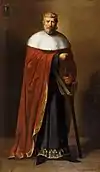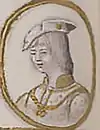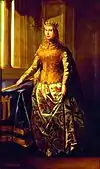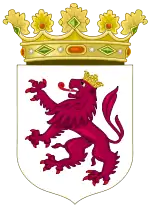Jiménez dynasty
The Jiménez dynasty, alternatively called the Jimena, the Sancha, the Banu Sancho, the Abarca or the Banu Abarca,[1] was a medieval ruling family from the 9th century which made part of most of the royal houses and kingdoms of the Iberian Peninsula of the time, namely, the Kingdom of Navarre, the House of Aragon and the Crown of Castile as well as of other territories in the South of France.[2][3][4][5]
| Jiménez | |
|---|---|
| Country | |
| Founded | 835 |
| Founder | Prince García Jiménez of Pamplona |
| Current head | Extinct |
| Final ruler | Sancho VII |
| Titles | Emperor of all Spain King of Leon King of Castile King of Galicia King of Aragon King of Pamplona King of Navarre King of Viguera Queen Consort of England Queen Consort of Sicily Count of Aragon Count of the Principate Count of Montescaglioso Countess of Champagne |
| Dissolution | 1234 |
History
The first known member of the family, García Jiménez of Pamplona, is obscure, it being stated by the Códice de Roda that he was "king of another part of the kingdom" of Pamplona, presumably lord of part of Navarre beyond the area of direct control of the Íñiguez kings: probably the frontier areas of Álava and the western Pyrenees given the list of their landholdings preserved in a later charter. It was long believed that their origins lay in Gascony. [6]
In 905 Sancho Garcés, a younger son of the dynasty founder, used foreign assistance to displace the Íñiguez ruler Fortún Garcés and consolidate the monarchy in his dynasty's hands. He would be viewed as founder of the dynasty, with several Iberian Muslim sources calling the family the Banu Sanjo (Arabic: بنو شانجه - the descendants of Sancho) for several subsequent generations, while a 12th-century Tunisian chronicler of Al-Andalus, Ibn al-Kardabūs, referred to Sancho III of Pamplona as ibn Abarca (Arabic: بن أبرك - son or descendant of Abarca), referencing a nickname originally borne by Sancho I in the naming of this Banu Abarca dynasty.[1] In addition to repulsing several attacks from the Emir of Córdoba, Sancho I crushed the neighboring Banu Qasi and thus expanded Pamplona to the upper Ebro River valley, as well as incorporating the previously-autonomous County of Aragon into the realm.
Following the death of Sancho in 925, his brother Jimeno Garcés maintained a position of strength, intervening in the politics of neighboring Christian and Muslim states. His death left the crown to his nephew, Sancho's son García Sánchez I, who was still a child. Originally ruling under the tutelage of his mother, the Íñiguez descendant Toda Aznar who established a web of political and marital alliances among the Iberian Christian states, invited the intervention of his cousin Abd-ar-Rahman III of Córdoba to achieve emancipation from his mother. Thereupon followed three generations of defeat and subjugation by the Caliphate. For his younger son, García created a short-lived sub-kingdom centered at Viguera, which lasted for several decades until its reabsorption into the Kingdom of Pamplona.
The latter only emancipated itself from Cordoban suzerainty during the reign of Sancho the Great, who ruled from 1000 to 1035 in Pamplona, but also ruled Aragon, Castile, Ribagorza and eventually León (but not Galicia) by right of conquest. He received the homage of the Count of Barcelona and possibly of the Duke of Gascony. After his coronation in León, he even took up the imperial title over all Spain. His vast domains were divided amongst his sons at his death, giving rise to three independent medieval kingdoms each ruled by a Jiménez monarch.
The Kingdom of Navarre, passing to the eldest son García, was unable to maintain its hegemony, leading to the full independence of Aragon under his illegitimate brother Ramiro I, who had previously taken over the territories of murdered brother Gonzalo of Sobrarbe and Ribagorza. Younger sibling Ferdinand I, then Count of Castile, killed in battle his nominal overlord the King of León and Galicia in 1037 and thereby inheriting them and bringing them fully into the orbit of his ruling clan. He then defeated García, achieving a sort of hegemony over his brothers, but again divided his realm among his sons. One of these, Alfonso VI, not only succeeded to the reunited realm of his father, but also conquered Toledo, reclaimed the imperial title and even pretended to rule over both Christian and Moslem Spain.
The Navarre branch of the dynasty went into eclipse when in 1076 Sancho IV was assassinated by his siblings, and his cousins Alfonso VI of Castile and Sancho Ramírez of Aragon converged and divided the kingdom, with the Aragon ruler gaining the Navarre crown, while ceding western lands to Castile.
The holdings of the family were briefly reunited when Alfonso the Battler of Navarre and Aragon married Alfonso VI's daughter Urraca, Queen of Castile and León, and claimed the imperial title. However, the marriage failed and the kingdoms of Castile and León passed out of the dynasty, to Urraca's son by a prior marriage. The Kingdom of Aragon and that of Navarre likewise went their separate ways following Alfonso's death, the former passing to his brother, the latter to a descendant of its original ruling family, with each eventually passing to other dynasties through heiresses: Petronilla of Aragon, who married the ruler of Barcelona and thus united those two realms into the Crown of Aragon; and Blanca, sister of Sancho VII of Navarre, whose 1234 death brought Jiménez rule to an end.
The Borgias of Italy in the 15th century would present a pedigree that traced their ancestry to Pedro de Atarés, lord of Borja, Zaragoza, who had been a competitor for the thrones of Navarre and Aragon following the death of Alfonso the Battler. Pedro was a scion of this family, being grandson of Sancho Ramírez, Count of Ribagorza, illegitimate brother of king Sancho Ramírez of Aragon. Such a descent would thus have made the Borgias male-line descendants of the Jiménez dynasty. However, the descent was a fabrication.
Rulers
Emperors in bold. Date of assumption of imperial title in bold and parentheses.
| Ruler | Born | Reign | Death | Ruling part | Consort | Notes | |
|---|---|---|---|---|---|---|---|
| García Jiménez |  |
c.835 | c.850-885 | After 885 | Pamplona | Oneca of Sangüesa two children Dadildis of Pallars four children |
Sub- or co-king in a part of Pamplona, during the rule of Garcia I Iñiguez and Fortún Garcés of Pamplona. |
| Sancho I Abarca |  |
c.860 | 905-925 | 10 December 925 | Pamplona | Toda Aznárez of Larraun seven children |
Elected king of Pamplona after Fortun Garcés' death. |
| Jimeno Garcés of Pamplona (regent) | c.860 | 925-932/3 | 932/3 | Pamplona | Sancha Aznárez of Larraun no children |
Brother of Sancho I. In spite of being titled as prince or king, he was merely regent for his nephew, Garcia. He also tutored the County of Aragon, whose heiress, Andregoto, was still a minor and promised to Garcia. | |
| Toda Aznárez of Larraun (regent) | .jpg.webp) |
2 January 876 | 925-933 | 15 October 958 | Pamplona | Sancho I of Pamplona four children |
Regent in name of her son. |
| Garcia II (Sánchez I) |  |
919 | 933-970 | 22 February 970 | Pamplona | Andregoto Galíndez, Countess of Aragon c.935 (annulled 943) one son Teresa of León c.943 three children |
Regent of his promised wife in Aragon until their marriage c. 935. With the dissolution of the latter in 943, the county was passed to Andregoto's child, and also heir to Pamplona. |
| Sancho II |  |
938 | 943-970 | 994 | Aragon | Urraca Fernández of Castile 962 four children |
Heir of Pamplona, he first inherited Aragon from his mother. He created the Kingdom of Viguera for his second son. |
| 970-994 | Pamplona & Aragon | ||||||
| Ramiro Garcés |  |
c.945 | 970-981 | 9 July 981 | Viguera | Unknown two children |
Son of Garcia Sánchez I (Garcia II) and Teresa of León. Inherited Viguera. |
| Sancho Ramírez | ? | 981-1002 | c.1002 | Viguera | Unknown a daughter? |
Left no male descendants and was succeeded by his brother. | |
| Garcia III (Sánchez II) the Trembling |  |
964 | 994-1000 | (29 July?) 1000 | Pamplona (994-997) Pamplona & Aragon (997-1000) |
Jimena Fernández of Cea c.988 four children |
|
| Urraca Fernández of Castile (regent) |  |
? | 994-997 | 1007 | Aragon | Urraca Fernández of Castile 962 four children |
Heir of Pamplona, he first inherited Aragon from his mother. He created the Kingdom of Viguera for his second son. |
| 1000-1014 | Pamplona & Aragon | ||||||
| Gonzalo Sánchez I | ? | 994-997 | 997 | Aragon | Unmarried | Ruled under regency of his mother, probably died still a minor. | |
| In 997 Aragon was reabsorbed in Pamplona | |||||||
| Garcia Ramírez | ? | 1002-1025 | c.1025? | Viguera | Toda two children |
After his death with no male descendants, Viguera was reabsorbed in Pamplona. | |
| In 997 Viguera was reabsorbed in Pamplona | |||||||
| Jimena Fernández of Cea (regent) | c.970 | 1000-1014 | c.1045 | Pamplona & Aragon | Garcia III (Sánchez I) c.988 four children |
Regent in name of her son, with her mother-in-law. | |
| Sancho III the Great | .jpg.webp) |
c.992 | 1014-1035 (1034) |
18 October 1035 | Pamplona & Aragon | Muniadona of Castile c.1011 five children |
After his death he made a division of land that would determine the evolution of three Iberian kingdoms: Aragon, Navarre and León-Castile. |
| Ramiro I |  |
1006/7 | 1035-1063 | 8 May 1063 | Aragon | Ermesinda of Foix c.1035 five children Agnes of Aquitaine I after 1049 no children |
Natural son of Sancho III, received Aragon. |
| Gonzalo Sánchez II | 1020 | 1035-1045 | 26 June 1045 | Sobrarbe & Ribagorza | Unmarried | Son of Sancho III, received the counties of Sobrarbe and Ribagorza, which came from his mother, who had rights over those territories. Left no descendants, and his territories went to his half-brother Ramiro. | |
| Sobrabe and Ribagorza were absorbed by Aragon | |||||||
| Garcia IV (Sánchez III) of Nájera |  |
1012 | 1035-1054 | 1 September 1054 | Pamplona | Stephanie of Foix 1038 Barcelona eight children |
Son of Sancho III, received Pamplona. |
| Ferdinand I the Great | .jpg.webp) |
1016 | 1029-1037 1037-1065 (1056) |
27 December 1065 | Castile Castile & León |
Sancha, Queen of León 1032 five children |
Son of Sancho III, received the county of Castile from his mother, Muniadona, in 1029. He also ruled, jure uxoris, the Kingdom of León with his wife Sancha from 1037. |
| Sancho IV the Noble |  |
1039 | 1054-1076 | 4 June 1076 | Pamplona | Plaisance of Normandy c.1068 three children |
Assassinated. He left a minor child, Garcia Sanchez, but he was considered not fit for the throne for his age, and the throne was given to the king of Aragon. |
| Sancho I & V |  |
1042 | 1063-1076 1076-1094 |
4 June 1094 | Aragon Aragon & Pamplona |
Isabella of Urgell 1065 (annulled 1070) one child Felicia of Roucy 1076 three children |
Son of Ramiro I, was chosen as the new king of Pamplona in 1076, reuniting both kingdoms once more. |
| Sancho II the Strong | .jpg.webp) |
1038/9 | 1065-1071 1071-1072 |
7 October 1072 | Castile Castile & León |
Alberta no children |
Son of Ferdinand I, from 1071 deposed his brothers and took briefly control of all the inheritance of his father, before he was assassinated. |
| Castile was reabsorbed in León | |||||||
| Garcia II |  |
1042 | 1065-1071 | 21 March 1090 | Galicia | Unmarried | Son of Ferdinand I, from 1071 he was deposed by Sancho II; tried to return after Sancho's assassination, but Alfonso arrested and banished him to the Castle of Luna, where he eventually died many years later. |
| Galicia was reabsorbed in Castile, and then in León | |||||||
| Alfonso VI the Brave | .jpg.webp) |
1040 | 1065-1071 1072-1109 (1077) |
21 March 1090 | León León & Castile |
Agnes of Aquitaine II 1073/4 no children Constance of Burgundy 1079 one child Bertha (of Savoy?) 25 November 1093 no children Isabel (Zaida?) c.1100 two (three?) children Beatrice (of Aquitaine?) 1108 no children |
Reunited the inheritance of his father, but left only a legitimate daughter, Urraca. |
| Peter I |  |
1068 | 1094-1104 | 28 December 1104 | Aragon & Pamplona | Agnes of Aquitaine III 1086 Jaca two children Bertha (of Savoy II?) 1097 no children |
Son of Sancho I/V. His own children didn't survive him and he was succeeded by his brother Alfonso. |
| Theresa |  |
1080 | 1096-1128 | 11 November 1130 | Portugal | Henry of Burgundy 1096 six children |
Daughter of Alfonso VI, co-ruled in Portugal with her husband since 1096. Her ambition of reuniting the county with the old Kingdom of Galicia, with her adoption of royal title from 1116, and alliances with important Galician families led the Portuguese nobles to support her son Afonso Henriques as a candidate for the comital throne. Deposed after her defeat at Battle of São Mamede in 1128. |
| With the death of Teresa the line of the Jimena family died out in Portugal, which was inherited by Afonso Henriques, from the Portuguese House of Burgundy. | |||||||
| Alfonso I the Battler |  |
1073 | 1104-1134 (1109) |
7 September 1134 | Aragon & Pamplona | Urraca I of León and Castile 1109 (annulled 1112) no children |
Died without descendants. After his death, Pamplona recovered its independence. |
| Urraca I the Reckless | .jpg.webp) |
April 1079 | 1109-1111 1109-1126 (1109) |
8 March 1126 | Galicia León & Castile |
Raymond of Burgundy c.1087 two children Alfonso I of Aragon 1109 (annulled 1112) no children |
Daughter of Alfonso VI, abdicated from Galicia to her son in 1111. Her problematic marriage with Alfonso of Aragon brought many conflicts between the spouses, even after their separation in 1112. Those conflicts endured throughout her reign. |
| With the death of Urraca the line of the Jimena family died out in León & Castile, which were inherited by Alfonso VII of León and Castile, from the House of Ivrea. | |||||||
| Garcia V (Ramírez) the Restorer |  |
? | 1134-1150 | 21 November 1150 | Pamplona | Margaret of L'Aigle 1130 four children Urraca of Castile the Asturian 24 June 1144 León no children |
Grandson of Sancho Garcés, illegitimate son of Garcia IV (Sánchez III) of Pamplona. |
| Ramiro II the Monk |  |
24 April 1086 | 1134-1157 | 16 August 1157 | Aragon | Agnes of Aquitaine IV 13 November 1135 Jaca (annulled 1136/7) one child |
Last surviving son of Sancho I/V. Withdrawn fom monastic life to inherit the throne. |
| Sancho VI the Wise |  |
1133 | 1150-1194 | 27 June 1194 | Navarre | Sancha of Castile 2 June 1157 Carrión de los Condes six children |
He was the first monarch to adopt the title King of Navarre. |
| Petronilla I |  |
29 June/11 August 1136 | 1157-1164 | 15 October 1173 | Aragon | Ramon Berenguer IV, Count of Barcelona August 1150 Lleida five children |
Petronila I of Aragon, from the House of Aragon, only daughter of Ramiro II, got married with Ramon Berenguer IV, ruler of the count of Barcelona. The dinastic union in 1137 gave rise to the Crown of Aragon. Through the prenuptial agreement (Capitulaciones matrimoniales) under Aragonese law, Petronila I was the sole queen, while Ramon Berenguer IV only becoming consort princeps but not king nor proprietor of the Kingdom of Aragon. After his death, Petronila abdicated in 1164 to their son, Alfonso II of Aragon who continued the dynasty of House of Aragon and also inheritating the title of count of Barcelona following his father's House of Barcelona. After the abdication, she pursued a monastic life for herself. [7] |
| Sancho VII the Strong |  |
17 April 1154 | 1194-1234 | 7 April 1234 | Navarre | Constance of Toulouse 1195 (annulled 1200) no children |
Left no descendants. The Navarrese throne went to his french nephew, the count of Champagne. |
| With the death of Sancho VII the line of the Jimena family died out in Navarre, which were inherited by Theobald I of Navarre, from the House of Champagne. As Sancho VII was the last living member of the family at the time of his death, Jimena dynasty became extinct after his death. | |||||||
Family tree of the House of Jiménez
| Aznar I count of Aragon HOUSE OF ARAGON | Íñigo king of Pamplona HOUSE OF ÍÑIGUEZ | ||||||||||||||||||||||||||||||||||||||||||||||||||||||||||||||||||||||||||||||
| Galindo I count of Aragon | García king of Pamplona | ||||||||||||||||||||||||||||||||||||||||||||||||||||||||||||||||||||||||||||||
| Athnar II count of Aragon | Onneca Garcés | Jiméno HOUSE OF JIMÉNES | (daughter) | Sancho | Fortún king of Pamplona | ||||||||||||||||||||||||||||||||||||||||||||||||||||||||||||||||||||||||||
| Garcia co- or sub-king of Pamplona | Aznar count of Laron/Larraun | Onneca Fortúnez | |||||||||||||||||||||||||||||||||||||||||||||||||||||||||||||||||||||||||||||
| Galindo II count of Aragon | Sancha Garcés | Sancho I king of Pamplona | Toda | Jiméno king of Pamplona | Sancha Aznares | ||||||||||||||||||||||||||||||||||||||||||||||||||||||||||||||||||||||||||
| Andregoto | Garcia I king of Pamplona, count of Aragon | ||||||||||||||||||||||||||||||||||||||||||||||||||||||||||||||||||||||||||||||
| Sancho II king of Pamplona, count of Aragon | Ramiro king of Viguera | ||||||||||||||||||||||||||||||||||||||||||||||||||||||||||||||||||||||||||||||
| Garcia II king of Pamplona, count of Aragon | Gonzalo count of Aragon | Sancho king of Viguera | Garcia king of Viguera | ||||||||||||||||||||||||||||||||||||||||||||||||||||||||||||||||||||||||||||
| Sancho III king of Pamplona, count of Aragon | Muniadona countess of Castile HOUSE OF BENI MAMADUNA | Alfonso V king of León HOUSE OF ASTUR-LEÓN | |||||||||||||||||||||||||||||||||||||||||||||||||||||||||||||||||||||||||||||
| (illeg.) Ramiro I king of Aragon HOUSE OF ARAGON | Garcia III king of Pamplona | Jiména | Bermundo III king of León | Ferdinand I king of Castile, León KINGDOM OF CASTILE-LEÓN | Sancha | Gonzalo count of Sobrabe & Ribagorza | |||||||||||||||||||||||||||||||||||||||||||||||||||||||||||||||||||||||||
| Sancho V king of Pamplona, king of Aragon | Sancho IV king of Pamplona | (illeg.) Sancho lord of Uncastillo | Ramiro lord of Calhorra | Sancho II kingof Castile | Alfonso VI king of León | Garcia II king of Galicia | |||||||||||||||||||||||||||||||||||||||||||||||||||||||||||||||||||||||||
| Peter I king of Pamplona, king of Aragon | Alfonso I king of Pamplona, king of Aragon | Ramiro II of Aragon king of Aragon | Christina (daughter of El Cid) | Ramiro lord of Monzón | Raymond CASTILIAN HOUSE OF IVREA | Urraca queen of Castile & León | Sancho heir apparent | Teresa countess of Portugal | Henry PORTUGUESE HOUSE OF BURGUNDY | ||||||||||||||||||||||||||||||||||||||||||||||||||||||||||||||||||||||
| Petronilla I queen of Aragon HOUSE OF ARAGON | Garcia IV king of Navarre KINGDOM OF NAVARRE | ||||||||||||||||||||||||||||||||||||||||||||||||||||||||||||||||||||||||||||||
| Alfonso II king of Aragon count of Barcelona CROWN OF ARAGON | Sancho VI king of Navarre | Henry count of Montescaglioso | |||||||||||||||||||||||||||||||||||||||||||||||||||||||||||||||||||||||||||||
| Sancho VII king of Navarre | Blanche regent of Navarre | Theobald III count of Campagne HOUSE OF BLOIS | |||||||||||||||||||||||||||||||||||||||||||||||||||||||||||||||||||||||||||||
References
- Alberto Cañada Juste, "¿Quién fue Sancho Abarca?, Príncipe de Viana, 73: 79-132.
- Linehan, Peter (1993). History and the Historians of Medieval Spain. Oxford, UK: Clarendon Press. ISBN 9780198219453.
- O'Callaghan, Joseph F. (1975). A History of Medieval Spain. Ithaca, NY: Cornell University Press. ISBN 9780801492648.
- Cañada Juste, Alberto (mayo-agosto 2011). «En los albores del reino ¿dinastía Íñiga?, ¿dinastía Jimena?». En Gobierno de Navarra, ed. Príncipe de Viana. ISSN 0032-8472. Consultado el 18 de octubre de 2014.
- Anónimo (junio de 2010). «Liber regum (o Libro de las generaciones y linajes de los reyes». Cuadro genealógico simplificado de los linajes regios navarros. e-Spania. Consultado el 18 de octubre de 2014.
- Roger Collins, The Basques (Blackwell, 1986), p. 163.
- Henry Kamen, Empire: how Spain became a world power, 1492-1762, 2002:20.
House of Jiménez | ||
| Preceded by House of Íñiguez |
 Ruling House of Pamplona 905 - 1234 |
Succeeded by House of Blois-Campagne |
| Preceded by (founder) |
.svg.png.webp) Ruling House of Aragon 948-1035 (as counts); 1035-1164 (as kings) |
Succeeded by House of Barcelona |
| Preceded by House of Beni Mamaduna |
 Ruling House of Castile 1037 - 1126 |
Succeeded by Castilian House of Ivrea |
| Preceded by House of Asturias-León |
 Ruling House of León 1037 - 1126 |
Succeeded by Castilian House of Ivrea |